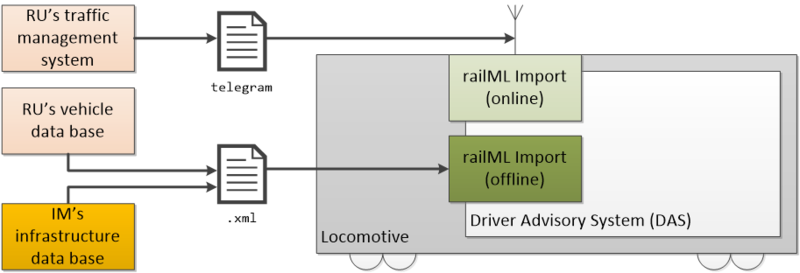UC:IS:DriverAdvisorySystem
Jump to navigation
Jump to search
|
| Driver Advisory System (DASY) Subschema: Infrastructure Related subschemas: TT RS Reported by: IS | ||
| ||
| For general information on use cases see UC:Use cases |
Use case / Anwendungsfall
Driver Advisory System (DAS); Fahrerassistentsystem
Description / Beschreibung
The Driver Advisory System (DAS) is an on-train driver support system which advises a driver on the most energy-efficient speed profile with which to meet the train’s current schedule. The DAS receives as input the current schedule (which may be updated at any time) together with a range of static or near-static data relating to the track, namely: topology, topography, asset locations and speed restrictions; and various parameters relating to the vehicle itself.
Data Flows and Interfaces / Datenflüsse und Schnittstellen
Data inputs
Track attributes (Infrastructure):
- Track Centre Line (as a polyline)
- Track altitude (polyline)
- Geometry: Track curvature
- Topology: Node-link model
- Route IDs
- Track IDs
- Mileposts / kilometre posts id, location
- Junctions id, location
- Loop ends id, location
- Platform ends platform ids, location
- Tunnels id, location (,envelope)
- Signals id, location, signal type
- Permissible speeds including permanent speed restrictions (PSRs), qualified by direction of travel and train type
- Temporary speed restrictions (TSRs), qualified by direction of travel and train type
- Emergency speed restrictions (ESRs)
- Locations of the following may also be required in the future (TBD):
- Signal berths id, location
- Bridges id, location
- Road crossings id, location
Schedule attributes (Timetable):
- Train Service Id
- (Sequence of) scheduled locations
- location name
- location as Track attribute
- For each passing location
- passing time and tolerance (before and after)
- For each stopping location
- arrival and departure times
Vehicle attributes (Rollingstock):
- Formation or consist
- (mass, length) profile
- Maximum speed
- Braking parameters (braking curve, brake delay, brake build-up)
- Traction parameters
- Coefficients of resistance
Data outputs
DAS operating logs
- Train id
- Time
- Train location
- Train actual speed
- Advised speed
- Driver entered parameters
Interference with other railML® schemas / Interferenz mit anderen railML®-Schemen
- rolling stock
- timetable
Characterizing Data / Charakterisierung der Daten
This section serves to specify the required data regarding certain aspects.
How often do the data change (update)?
- Track attributes: nearly static except for TSRs and ESRs (weekly/daily)
- Schedule attributes: daily, with realtime changes
- Vehicle attributes: occasional changes (event-driven)
How big are the data fragments to be exchanged (complexity)?
- huge (region)
Which views are represented by the data (focus)?
- Train regulation
- Energy
Which specific data do you expect to receive/send (elements)?
|

